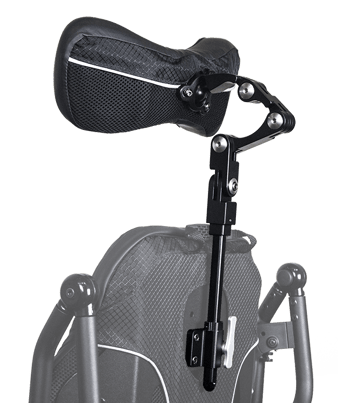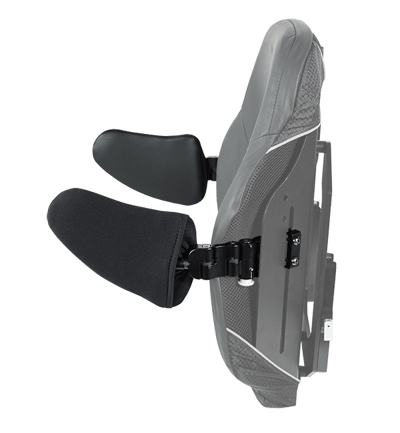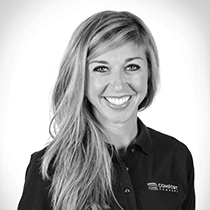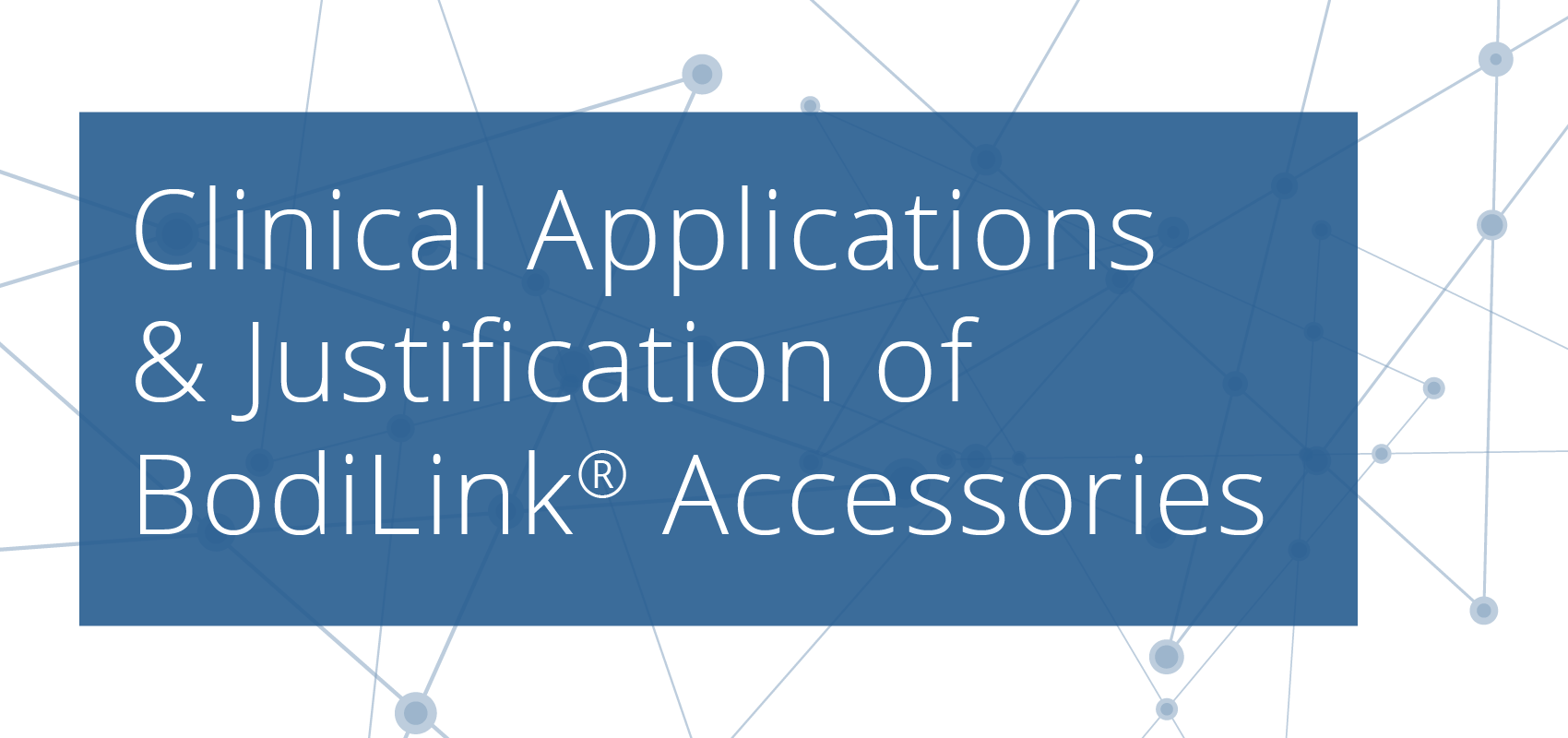In this series we're taking a closer look at justification and clinical tips for a few seating and positioning accessories. See Part 1, Part 2, and Part 3.
Over the last three weeks we've discussed the clinical applications and justifications of head supports, lateral upper leg (thigh) supports, and lateral trunk supports. This week we're going to look at clinical applications for the new BodiLink accessory family along with sample justification. Lindsey Sharpe DPT, PT has provided clinical tips for each part of our BodiLink family.
BodiLink Head Support
With completely reimagined hardware, a variety of pad and cover styles you will never have to sacrifice the comfort you deserve for the durability you need. Experience precise alignment, greater surface contact and more stable head positioning with the improved BodiLink Head Support.

Clinical Tips
PADS:
- Hinged premium pads are adjustable to accommodate minor to moderate lateral-forward flexion and prevent the need for a more restrictive 3-point system
- The premium pad shape facilitates improved interaction with the environment through cut-outs that increase line of sight
- New BodiLink hardware allows increased adjustability to accommodate offset head positioning needs
- BodiLink PT hardware is the strongest on the market, minimizing the possibility of hardware failure with high-tone clients
- PT hardware is recommended for high-tone clients and/or heavy use clients
- The PT Max 8 hardware options have over 12” vertical, 7.5” anterior, 3” posterior, and 8” lateral reach, offering nearly unlimited adjustability to accommodate a variety of complex postural and positioning needs
- The Gear-Teeth Midline hardware easily meets the needs of a high functioning client who requires head-support only when the chair is in tilt/recline with no need for offset capability
- GlideWear cover protects clients from the development of bald spots and pressure injuries on the head resulting from friction and shear for high-tone clients and/or clients with significant involuntary movement in the chair
- Comfort-Tek cover is durable and easily cleaned with common disinfectants without having to remove it from the pad, making it an ideal option for facilities where the head support will undergo multi-patient use
Sample Justification
The justifications provided are meant to be examples only and are not all-inclusive. There are many reasons why an individual might need a specific product or feature and many ways to explain the need.
- Necessary to support the client’s head while in the wheelchair when utilizing the tilt and recline features.
- Helps to compensate for his/her inability to maintain an upright head position throughout the day due to muscle weakness (abnormal tone, poor balance and stability, poor endurance, other)
- Necessary to prevent development (progression) of postural abnormalities that could result in impaired respiration, unsafe swallowing, poor visual field and decreased ability to interact with his environment.
- The padding and GlideWear cover provide comfort and skin protection during prolonged sitting and when he/she experiences spasticity and increased tone.
BodiLink Lateral Pelvic/Thigh Supports
BodiLink Lateral Pelvic/Thigh Supports are compatible on virtually any power or manual wheelchair. New telescoping taper hardware, fixed or removable with release lever, and ten zero elevation or anti-thrust pad sizes, make BodiLink a versatile solution for any lateral support need.

Clinical Tips
PADS:- Anti-thrust lateral pelvic/thigh support pad is NOT intended to prevent the pelvis from sliding forward or into posterior pelvic tilt. It is available so that lateral/pelvic thigh supports can be utilized with clients who require anti-thrust cushions for positioning
- TT hardware allows medial/lateral offset capability to accommodate a significant non-reducible windswept position in order to prevent the abducted lower extremity from worsening and provide contact to the lateral aspect of the adducted lower extremity for stability
-
A set of two TT hardware can be used per side for high tone patients expected to exceed 150lbs of lateral loading per side
-
For clients with decreased dexterity or significant hand weakness, the new trigger-release was developed based on the hand-function of a C5-6 SCI patient to allow independent release and, therefore, increased independence during transfers and MRADLs
-
Medium size TT hardware will accommodate most off-the-shelf rehab cushion heights
-
The large size TT hardware will accommodate a thicker custom cushion or most custom molds
Sample Justification
The justifications provided are meant to be examples only and are not all-inclusive. There are many reasons why an individual might need a specific product or feature and many ways to explain the need.
- Correct (prevent further progression of) his/her tendency to fall into hip abduction and external rotation due to LE weakness (abnormal tone, poor motor control poor endurance, fatigue, pain, other)
-
Provide midline LE alignment and increased pressure distribution to the femurs to reduce his risk of pressure injuries due to (list specific risks for this person)
BodiLink Lateral Trunk Supports
BodiLink Lateral Trunk Supports are designed with your body’s shape in mind. The modular design and unique wrist joints make setup and adjustment easy and our 48 different pad options including, basic, premium, moldable and rigid ensure that you will get the exact support that you need.

Clinical Tips
PADS:- The premium pad is the ideal solution for heavy use clients as the skinned foam makes breakthrough nearly impossible, reducing the risk of skin breakdown or pain due to metal exposure
-
The moldable pad option allows the lateral trunk supports to be precisely conformed to the unique shape of the user for improved pressure distribution
-
The active pad style is ideal for active clients who participate in ADLs and have functional use of their upper extremities
-
The supportive pad style is more restrictive and supportive for clients who require the additional support
- The GT2 hardware is optimal for clients with high tone and/or spasticity to prevent hardware failure
-
The GT2 hardware offers a nearly limitless rotation to match the patient angle, allowing precise contact and increased surface area to prevent leaning on the top edge of the pad, i.e. think about your scoliotic clients
- The GlideWear cover is optimal for clients with high tone that results in unwanted minor movement and shear and will reduce the chance of skin breakdown due to shear and friction
-
The GlideWear cover can be used with clients who need to be allowed to make slight movements for the reduction of tone/spasms or anxiety, i.e. think about your clients who utilize dynamic components on their chairs
-
½” non-zeroing foam cover option results in a soft end-feel despite high pressure minimizing unwanted movement related to discomfort, i.e. high-tone clients or clients with reducible scoliosis needing significant opposing forces to correct
Sample Justification
The justifications provided are meant to be examples only and are not all-inclusive. There are many reasons why an individual might need a specific product or feature and many ways to explain the need.
- Correct (prevent further progression of) his/her right lateral lean (scoliosis) due to trunk weakness (abnormal tone, poor motor control, poor endurance, fatigue, pain, other)
Provide proximal stability to the trunk to allow use of his/her UEs for function
-
Provide a counterpoint to help correct (prevent further progression of) his trunk rotation
-
Provide proper trunk alignment to ensure improved pressure distribution, decreased fatigue in sitting, decreased secondary postural changes, improved respiration and swallowing.
Thanks for following us as we’ve discussed our BodiLink family. We want to know your experience with our new products so send us your feedback. We are committed to providing our end users with the best possible products, and we always value your comments!

Stacey Mullis, OTR/ATP
Director of Clinical Marketing
Stacey is Director of Clinical Marketing. She graduated from Western University in London, Ontario, Canada with a BA Linguistics and BSc Occupational Therapy and has practiced as an OTR for over 20 years. With experience in pediatrics, inpatient/outpatient rehabilitation, long term care, and home health, Stacey has faced the challenges first hand of providing appropriate seating in various clinical settings. This led her to pursue an apprenticeship at Care Partners Seating Clinic in Asheville, NC to advance her skills, and she obtained her ATP certification in 2012. Mullis is a member of the NCOTA, CTF, NRRTs, RESNA, and AOTA.

Lindsey Sharpe, PT, DPT
Lindsey Sharpe graduated with a BA in Exercise and Sport Science from the University of North Carolina at Chapel Hill in 2007 and with her Doctor of Physical Therapy from Elon University in 2010. Lindsey was a practicing clinician for seven years primarily focusing on neurological conditions and wheelchair seating and positioning.
Lindsey was first introduced to wheelchair seating and positioning during her time on the spinal cord injury team at the University of Virginia's acute rehab hospital where she discovered her interest in and passion for this niche in the therapy world. Lindsey went on to open a brand-new seating clinic with Carolinas Healthcare System in Concord, NC where she advanced her knowledge and skills performing both inpatient and outpatient seating evaluations for clients of all ages having a variety of diagnoses.

